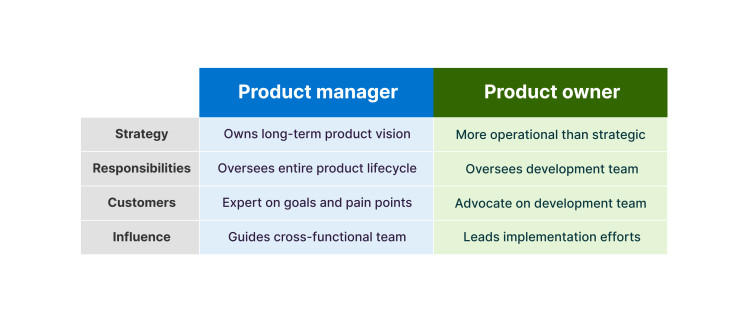
The Product Manager vs. Product Owner
Some people say to never read the comments. But I read as many as I can — even if I am not able to reply to each one. Take this comment on a post I wrote about different product management roles. Tammy made a compelling analogy about clothing manufacturers. She wrote that developers are like tailors, since they actually stitch together the code. But there is a lot of other work that goes into a garment, such as creating the pattern, sourcing materials, and coordinating with distributors. No matter what you are building, you need specialists who can help.
This is where product managers and product owners come in — each brings their own skills to help deliver what customers need.
In small or mid-sized companies, there may not be a need for these distinct roles. One person can (and I have often argued should) handle it all — setting the product direction and working with engineering teams on resourcing and detailed requirements. But in larger organizations and agile teams, the responsibilities are typically split in two because of the complexity and attention needed to do each job well.
Product managers really, really love Aha! Roadmaps — try it free.
In companies with both positions, the product manager adopts a more outward view. They set the product vision and strategy, analyze the market and competitors, and engage with customers to better understand their pain points. The product owner, meanwhile, takes a more internal and technical approach. They primarily support the development team by gathering requirements, creating user stories, and prioritizing the product backlog.
So why separate the product leader into two roles? The impetus is distinct focus areas that drive business growth.
Or at least, that is when it makes the most sense. When the volume of work becomes too large for one person to handle, many companies divide the strategic and tactical product work. Ideally, the product manager focuses more on strategy and customers while the product owner concentrates on supporting internal teams, particularly engineering.
But in reality, the roles are not always so cleanly delineated. Undefined, vague, or overlapping responsibilities can lead to confusion about who does what. And clashing perspectives often lead to feelings of frustration.
In prior companies, I have seen the product manager blame the product owner when the development team struggled to meet deadlines. The product manager was so intent on delivering against the product strategy that they forgot the product owner was leading a group with limited capacity. Little empathy and even less communication led to dysfunction.
Conflict can cause a rift that hurts the entire team — trust deteriorates, morale suffers, and the delivery of the product is ultimately impacted.
Cooperation begins with a shared understanding. Both the product manager and product owner contribute to the overall success of the product but in different ways. Here is an overview of the two positions and how they can create a productive working relationship:

Strategy
The product manager owns the long-term product vision. They manage the product roadmap and communicate the strategy to the rest of the team. They link the "why" to the "what" — making sure that everyone understands how their work contributes to the broader goals and initiatives.
The product owner is more operational than strategic. They communicate the planned features and needed functionality to the development team. Instead of building or maintaining the product roadmap, they work to support the product strategy set by the VP of product or the product manager.
How to make the relationship great: Discuss strategy often. Product managers should openly share objectives with the product owner and review the product roadmap. This helps the product owner avoid making ad hoc prioritization decisions that might conflict with broader business priorities. In turn, product owners should ask product managers for additional clarity when they need more information about what is most important — always pushing to understand why.
Responsibilities
The product manager oversees the entire product lifecycle. They define the release process and capture the cross-functional activities needed to bring the product or feature to market. They also gather feedback from customers and teammates, adding the best ideas to the product roadmap.
The product owner oversees the development team. They write requirements and user stories, manage the product backlog, and answer questions that the engineering team has about what should be built next. On agile teams, the product owner manages sprints and participates in retrospectives.
How to make the relationship great: Fill in for each other every so often so you know firsthand what the other person's role actually entails. If this is not possible, establish a process for sharing information with each other. Schedule recurring meetings or simply set designated times for the product manager to share their subject matter knowledge with the product owner. This gives the product owner the context they need to write compelling user stories for the development team.
Customers
The product manager has deep knowledge of what customers want to achieve and how to solve their pain points. Besides creating user personas, product managers gather feedback and ideas from customers about their experience using the product. Some product managers also cultivate customer empathy by scheduling empathy sessions — online conversations with customers to learn more about their challenges and the features they would like to see in the future.
The product owner serves as the customer expert for the development team. Throughout each sprint, they guide the engineering team to build new features or functionality — always keeping customer needs at the forefront of their mind. They also make sure acceptance criteria are met and decide when user stories are complete.
How to make the relationship great: Approach customer needs with curiosity. The product manager should equip the product owner with insights into customer requests and the product owner should ask for relevant information about the user experience. This empowers the product owner to prioritize the product backlog and support the development team as they build the features that users desire.
Influence
The product manager leads the cross-functional product team. Although they do not typically manage people, the product manager works closely with folks from sales, support, marketing, and engineering. They also communicate progress to executives and are ultimately responsible for meeting company and product objectives.
The product owner leads the development team's implementation efforts. They work closely with the product manager and other members of the product team to determine which features the development team will tackle next. They may also work with UX to define detailed requirements and create mockups.
How to make the relationship great: Recognize each other as equals. Although the product manager has more strategic responsibility, they are not more important than the product owner or anyone else on the team. Organizationally, it makes sense that rather than have the product owner report to the product manager, both should report to the same person (typically a director of product).
Ultimately, the product manager and product owner both work towards the same goal — delivering an experience that customers love.
A constructive relationship grows from clearly defined expectations and regular communication. But you also need empathy, compromise, and flexibility. For example, if scope changes at the last minute, resist the urge to blame or undermine your colleague in front of the team.
Be a united front and work together to identify solutions that satisfy everyone. When you have a deep respect for the unique skills that the product manager and product owner each bring, the building process goes much more smoothly. And you will enjoy a stronger, more tight-knit relationship.
Build better products with Aha! — sign up for a free 30-day trial.




